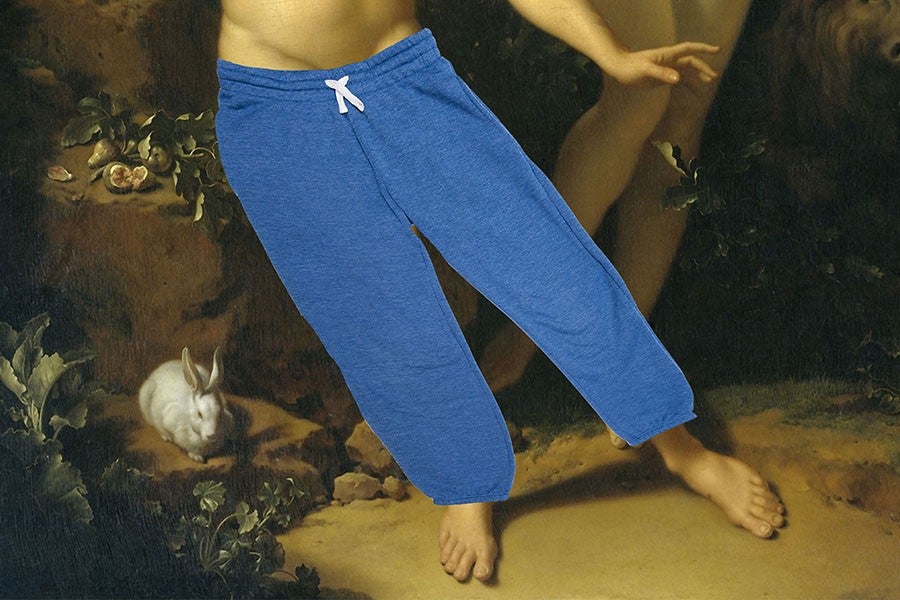Let me make a safe assumption: You’re probably at home this morning feeling uncomfortably bloated from yesterday’s Thanksgiving dinner. Most likely, you’re lounging around in your sweatpants as the waistband expands and contracts with each labored breath.
Of course, nowadays, you could leave the house in your sweatpants and no one would care. Even some work environments have embraced the “athleisure” trend, which has made sportswear acceptable in public. It turns out that the ultimate in unflattering apparel has become perfectly normal for most social occasions — and offices.
But how did this societal breakdown occur?
When sweatpants were originated in the 1920s, their creator, Le Coq Sportif founder Émile Camuset, saw them as much-needed comfortable sportswear for athletes of the day. The simple gray sweatpants — named for their ability to absorb sweat (duh) — were a utilitarian but highly effective answer to the tight-fitting trousers that had dominated men’s fashion since the French Revolution.
“Sweatpants were very much associated with sport following their invention,” explains Shaun Cole, a cultural and fashion historian at the London College of Fashion. “They were popularized as ideas of health and an athletic body became more fashionable.” They quickly began appearing at the Olympics, and it was commonplace to see athletes wearing them there by 1936. Still, while seeing athletes in sweats would help to popularize them, for the next few decades they would remain strictly workout attire.
It remained this way until the 1980s. (Though it should be mentioned that 1976 was a landmark year for sweatpants, with Rocky featuring one of the most iconic sequences in film history.) “The growth in gym use and the new waves of health and fitness in the 1980s certainly saw the move of sweatpants from the sports-specific context to a more general leisurewear one,” Cole explains. Jane Fonda’s iconic 1982 workout video helped things along as well. From there, says Cole, “The casualization of fashion set a tone in which men and women could acceptably be dressed in this way.”
https://www.youtube.com/watch?v=AdbjM0nZClw
A debt of gratitude is also owed to a 1971 conference between gang leaders in the Bronx. The Hoe Avenue Peace Meeting was a gathering of more than 40 of New York’s top gangs where they laid out a plan to end street violence. This meeting is widely credited with the birth of hip hop, as many disputes that once would’ve been settled with weapons were now settled with rap battles and break dancing. The regalia for such battles? The track suit. As chronicled in The Daily Beast, the tracksuit allowed for comfort and mobility, while simultaneously being available in a wide variety of colors. When Run DMC hit the scene in matching Adidas tracksuits, it would forever be a part of hip-hop culture.
But those pockets of cultural change still didn’t permeate the mainstream for some time — as late as 1993, Jerry scolded George on Seinfeld for wearing sweatpants in public, informing him he’s just telling the world that he’s given up. And 11 years later, one of the Mean Girls was ostracized for wearing them on a Monday.
Not that there wasn’t some movement toward acceptance. In 1998, the debut of premium-priced yoga pants by Lululemon would give women tight-fitting sweatpants that were much more flattering than the traditional baggy type. That really was the genesis of where we’re at today and the precursor to 2013, the year the athleisure trend hit the mainstream. Case in point: In 2013, under his stage name Childish Gambino, Donald Glover released his hit single “Sweatpants,” a song that was neither about, or even featured the word “sweatpants”: When asked about this, Glover offered the explanation, “Rich people wear whatever they want.”
2013 was also the year denim sales started taking a big hit — about 5 percent — a trend that’s continued every year since. Meanwhile, around that time, Aeropostale, Urban Outfitters, American Eagle and H&M (among others) started featuring athleisure clothing lines. “Athleisure is an interesting concept in bringing together a new idea about athleticism and health consciousness with designer-price branded or produced clothing,” explains Cole. The movement has become so popular that the practicality has become secondary to the look, with Cole citing examples of cashmere sweatpants as the prime example of impractical athletic wear.
So what does this mean for you and your sweatpants as you stare into the refrigerator at endless leftovers? If you’re staying home, nothing. But if you become a bit stir-crazy and decide you really want to see if Best Buy has any discounted Fitbits left on this Black Friday, know that you won’t have to waste any time changing your clothes. Because the sweatpants you once employed mainly to ease your bloat now mean you’re completely fashionable and totally on-trend.

